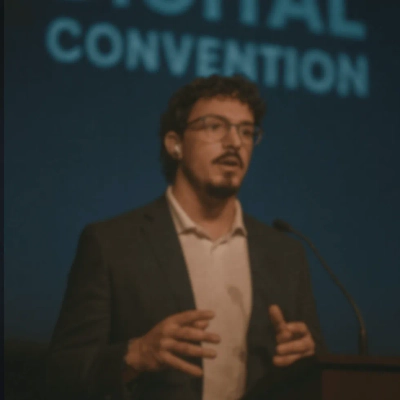High-risk investments can be a game-changer for those willing to take calculated risks. This article presents valuable lessons from successful high-stakes ventures, drawing on the expertise of seasoned investors and entrepreneurs. Discover key strategies that have turned risky bets into lucrative opportunities across various industries.
- Back Raw Insight Over Polished Pitches
- Seize Opportunities During Market Downturns
- Create Value for Established Communities
- Streamline Product to Boost User Engagement
- Lead Digital Transformation Despite Skepticism
- Craft Compelling Narratives for Premium Products
- Combine Research with Market Gap Analysis
- Leverage Client Relationships for Business Growth
- Invest in Future Needs, Not Current Limitations
- Address Verified Customer Pain Points
- Form Strategic Partnerships to Mitigate Risk
- Apply Unique Expertise to Investment Decisions
- Invest in Business Education for Success
- Narrow Focus to Expand Market Opportunities
- Take the Leap into Entrepreneurship
- Build Relationships and Solve Problems Persistently
- Improve Patient Experience to Accelerate Growth
- Prioritize Sustainable Growth Over Quick Scaling
Back Raw Insight Over Polished Pitches
One of the riskiest bets I made early on with Spectup was backing a startup that had no product, just a rough concept and a founder who could barely pitch. Everyone else passed on them. But I saw something—raw insight into a growing pain point in B2B logistics that no one was tackling properly. We helped the founder build the pitch from scratch, walked him through investor conversations, and refined the value proposition until it clicked. It was chaos in the beginning—missed meetings, messy decks, emotional calls—but eventually, he secured a €1.5M seed round. That startup now has enterprise clients across Europe and is scaling steadily.
What I learned is this: product traction matters, yes, but sometimes backing the founder’s insight and commitment—if they’re obsessively close to a problem—is the best signal. Most people wait for proof; occasionally, being early with the right support makes all the difference. But you have to be all-in. Half-committing to a high-risk case is worse than not engaging at all.
 Niclas Schlopsna
Niclas Schlopsna
Managing Consultant and CEO, spectup
Seize Opportunities During Market Downturns
One of the highest-risk investments I made was committing a significant portion of my available capital into a new service offering during a market downturn. On paper, it wasn’t the “safe” move—demand was uncertain, budgets were tightening across industries, and most peers were cutting costs rather than expanding. But I saw a gap forming: while competitors were pulling back, clients still needed strategic support, just in a more flexible, outcomes-focused format.
The investment wasn’t just financial—it was time, team bandwidth, and brand equity. We had to build the offering from scratch, reposition it, and launch it quickly enough to capture early adopters before the window closed. That meant diverting resources from established revenue streams, which added another layer of risk.
Within six months, the bet paid off. Not only did the new service gain traction, it became one of the highest-margin parts of the business and opened doors to clients we’d been trying to reach for years. The early mover advantage was real—because we showed up when others hesitated, we became the go-to partner in that space.
The lesson I took away is that high-risk moves aren’t about ignoring the downside—they’re about calculating it and having a clear thesis on why the upside outweighs it. For me, that meant asking three questions: Is there a genuine unmet need? Can we execute fast enough to be first or best? And if it fails, will we still have enough runway to recover?
Taking big swings is easier when you know your floor—what you can lose without jeopardizing the whole operation. That clarity lets you move decisively when opportunities appear, even if the timing isn’t perfect. In this case, imperfect timing was exactly why it worked.
 John Mac
John Mac
Founder, OPENBATT
Create Value for Established Communities
One of the riskier investments I made was developing a specialized comparison tool for cashback rates and offering it to a large Facebook deal-hunting community with 300,000 members. This required significant resource allocation and development time with no guarantee of acceptance or return on investment. The risk paid off substantially, resulting in doubled engagement, a significant increase in content sharing, and a 40% jump in referral traffic that brought thousands of new loyal users to our platform. The key lesson I learned was that providing genuine value to established communities, rather than just traditional advertising, can create powerful partnerships that benefit both parties. When taking similar risks, I would advise others to focus on creating tools or resources that solve real problems for your target audience, as utility-driven approaches often generate more sustainable growth than promotional campaigns alone.
 Ben Rose
Ben Rose
Founder & CEO, CashbackHQ.com
Streamline Product to Boost User Engagement
The riskiest investment I ever made wasn’t in a stock or a startup — it was in deleting 90% of my company’s product features overnight. We had a Swiss Army knife kind of platform that tried to be everything for everyone, and growth had flatlined. I kept hearing “this could be huge” from investors and friends, but deep down I knew we were selling a cluttered, unfocused experience.
So I took the leap: fired our “everything” roadmap, kept only one feature, and rebuilt the company around it. We lost a chunk of our users instantly. It hurt. But the ones who stayed? They became obsessed. They told their friends. They gave us clearer feedback than we’d ever gotten. Within a year, revenue per user tripled, churn halved, and we’d found a brand identity that didn’t feel like a Frankenstein’s monster of features.
The lesson? Sometimes the boldest investment isn’t adding more, it’s cutting almost everything and doubling down. The market rewards clarity of purpose way more than breadth of offering.
 Derek Pankaew
Derek Pankaew
CEO & Founder, Listening.com
Lead Digital Transformation Despite Skepticism
One of the highest-risk investments I made in my career involved spearheading a complete digital transformation for an established retail brand during my time as Head of E-Commerce. The company was heavily reliant on physical stores, and the leadership team faced significant skepticism about shifting major resources toward digital channels, especially given the upfront costs and the cultural resistance within the organization.
The core risk was not simply financial. We were challenging legacy business models, retraining large teams, and effectively reimagining the customer experience from the ground up. We invested in building a robust omnichannel infrastructure, integrating real-time inventory, launching new mobile and web platforms, and reengineering our marketing strategy around data and performance metrics. At the time, the industry was still split on whether physical-first retailers could thrive online at scale.
Success did not come overnight. The first year tested our operational resilience as we navigated technical setbacks, staff turnover, and constant pressure to demonstrate early results. However, we persisted in measuring the right KPIs, iterating on customer feedback, and investing in digital talent. By the second year, online revenue grew well beyond initial forecasts, and the business achieved true channel integration, which later became a benchmark for others in the industry.
The most valuable lesson I took from this experience is that high-risk investments demand more than financial commitment – they require a willingness to challenge entrenched assumptions and to build organizational alignment around a shared vision. Success comes from disciplined execution, transparent communication, and the courage to make short-term sacrifices for long-term gain.
In my consulting roles since, and through initiatives at ECDMA, I advise leaders to approach high-risk digital investments not as isolated bets but as long-term transformations that will test both business fundamentals and leadership resolve. The returns are significant for those who are willing to take calculated risks, remain adaptable, and create a culture that supports continuous change.
 Eugene Mischenko
Eugene Mischenko
President, E-Commerce & Digital Marketing Association
Craft Compelling Narratives for Premium Products
I once committed to purchasing a rare, high-grade coffee lot at a price well above our usual range, without knowing if our customers would respond to it. The risk was that the beans were a one-time offer, so if they did not sell, the cost would hit our cash flow hard. I decided to move forward and build a limited-release campaign around the story of the farm, the harvest conditions, and why this lot was unlike anything else we had roasted.
The batch sold out in under two weeks, and it attracted new customers who later became regular buyers. The main lesson was that a high-risk investment feels less risky when you can create a strong narrative and clear reason for its value before you commit. If you can connect people to the “why” behind the product, they are more likely to take the leap with you.
 Rory Keel
Rory Keel
Owner, Equipoise Coffee
Combine Research with Market Gap Analysis
I invested in a small renewable energy startup three years ago, even though their technology was unproven and the market was crowded. I spent weeks analyzing their patents, team experience, and pilot project results before committing. The risk paid off when the company landed a major government contract, and my early investment grew fivefold. The biggest lesson I learned is that high-risk investments can succeed when you combine thorough research with a clear understanding of the market gap. It’s not about luck—it’s about identifying opportunities where others see uncertainty and being disciplined enough to assess the fundamentals. For anyone taking similar risks, I’d advise breaking down the investment into measurable factors—team credibility, traction, and scalability—rather than relying on hype or speculation. This approach keeps risk manageable while still allowing for significant upside.
 Nikita Sherbina
Nikita Sherbina
Co-Founder & CEO, AIScreen
Leverage Client Relationships for Business Growth
One of my most successful high-risk investments was developing a closed referral system for my coaching business instead of relying on traditional advertising channels. I carefully selected ten of my best clients and asked each to refer just one person, providing them with unique insights about my services to share. This approach required me to trust my existing client relationships and bet on the power of personal recommendations over paid marketing, which felt risky at the time. The strategy generated $120,000 in new business within just four months without spending a dollar on advertising. The key lesson I learned is that sometimes the most effective business growth comes from deepening existing relationships rather than constantly chasing new ones. When you provide exceptional value, your clients can become your most powerful marketing asset.
 Wayne Lowry
Wayne Lowry
CEO, Scale By SEO
Invest in Future Needs, Not Current Limitations
When expanding our business operations, I made the decision to invest in a commercial property that was twice the size of what we initially needed, which represented a significant financial commitment and risk at that time. The conventional wisdom would have been to purchase only what was necessary for our immediate requirements, but I had a strong belief in our growth trajectory and wanted to avoid the disruption of relocating again in the near future. This calculated risk proved to be one of my better business decisions as we fully utilized the additional space within just four years, saving us from the substantial costs and operational challenges of finding and moving to a new location during our growth phase.
The key lesson I learned, which I believe applies to many risk scenarios, is that sometimes you need to make decisions based on where you’re going rather than where you currently are. When taking similar risks, I would encourage others to thoroughly analyze their growth projections, ensure they have contingency plans in place, and remember that timing is often just as important as the decision itself.
 Evan McCarthy
Evan McCarthy
President and CEO, SportingSmiles
Address Verified Customer Pain Points
One of the most significant risks I took was investing substantial capital into building an expensive tool connection that our customers had been requesting. At the time, the financial commitment was concerning given our budget constraints, but customer feedback strongly indicated this would address a critical need. The investment proved successful beyond our expectations, significantly increasing platform usage and ultimately becoming a key differentiator for our business in a competitive market.
The most valuable lesson I learned was that carefully listening to customer needs, even when addressing them requires substantial risk, often leads to the most meaningful business growth. I would advise others considering similar risks to thoroughly validate customer requests through multiple channels before committing, but not to shy away from investments that directly address verified customer pain points.
Sometimes the features customers are most vocal about truly represent untapped market opportunities that competitors have overlooked.
 Piotr Zabula
Piotr Zabula
CEO, Cropink.com
Form Strategic Partnerships to Mitigate Risk
One of the most significant risks I took early in my entrepreneurial journey was allocating our extremely limited resources toward a cross-promotion marketing strategy with adjacent local businesses. As a first-time entrepreneur, committing to this joint giveaway initiative felt particularly daunting since we had very little margin for error with our budget. The strategy involved pooling our social media presence and email lists with complementary businesses to create a unified promotional campaign that would benefit all participants. This calculated risk paid off remarkably well, doubling our market reach and generating dozens of new leads within just one week. The key lesson I learned, which I believe applies to many risk-taking scenarios, is that strategic partnerships can significantly reduce individual exposure while multiplying potential rewards. When considering high-risk investments, look for opportunities where resources can be combined with others to create mutual benefit rather than shouldering the entire burden alone.
 Ahmed Yousuf
Ahmed Yousuf
SEO Expert & Financial Author, Customers Chain
Apply Unique Expertise to Investment Decisions
My first major investment risk was purchasing a run-down property in North Las Vegas right after college, despite having limited capital and experience. By applying my engineering background to strategically plan renovations that maximized value rather than just aesthetics, I was able to transform the property and generate a $40,000 profit. The success of this project taught me that calculated risks combined with your unique expertise can create significant opportunities, even when conventional wisdom might suggest otherwise. The experience showed me that your specialized knowledge, when applied to investment decisions, can be your greatest competitive advantage.
 Casey Ryan
Casey Ryan
Founder, We Buy Any Vegas House
Invest in Business Education for Success
One of the riskiest investments I made was allocating substantial resources toward professional development when my business was still in its early stages. Despite having technical expertise in my field, I recognized an opportunity to enhance my business acumen and took the calculated risk of investing time and money in specialized courses and workshops focused on business fundamentals. This investment proved invaluable as I learned critical skills in value-based pricing, service productization, and creating repeatable systems that ultimately transformed my company’s profitability and scalability.
The key lesson I learned, which would benefit anyone taking similar risks, is that technical proficiency alone rarely translates to business success without corresponding investment in entrepreneurial education. I would encourage others to view professional development not as an expense but as a strategic investment, particularly when complemented by building relationships with peers who can provide practical insights into common business challenges.
 Brandy Morton
Brandy Morton
Founder & CEO, Brandy Morton Marketing Ltd. Co.
Narrow Focus to Expand Market Opportunities
One of the riskiest business investments I made was deciding to narrow our customer focus to a specific niche when our company was struggling with low lead generation. At the time, I strongly resisted this approach, concerned that specializing would significantly limit our market potential and overall business growth. After careful analysis and facing continued challenges, we took the leap and completely realigned our strategy to focus exclusively on a specific customer segment. This decision fundamentally transformed our business by allowing us to craft clearer messaging, develop more targeted offerings, and attract precisely the type of clients we were best positioned to serve. Looking back, the valuable lesson was that sometimes narrowing your focus actually expands your opportunities rather than limiting them. I would advise others facing similar decisions to recognize that specificity in business strategy often creates clarity that resonates more powerfully with customers than trying to appeal to everyone.
 Raphael Larouche
Raphael Larouche
Founder & SEO Specialist, Zenith
Take the Leap into Entrepreneurship
Leaving a lucrative career in medical sales to launch ANEA HILL was the boldest risk I ever took. My husband and I invested the cash we had in our pockets into creating a luxury sunglasses brand from scratch, without outside funding or a safety net. It was terrifying and exhilarating at the same time. The lesson I learned is that you will never feel fully ready to start something new. If you wait for the perfect moment, it will never come. My advice to women considering a leap into entrepreneurship is simple: go. Trust yourself, take the step, and figure it out along the way. Courage creates momentum, and momentum builds success.
 AshLee Williams
AshLee Williams
Founder, Designer, www.aneahill.com
Build Relationships and Solve Problems Persistently
Investing in real estate while still in college was certainly a high-risk move that ultimately transformed my financial trajectory. What began as a single property purchase eventually grew into a rental portfolio substantial enough to provide complete financial independence from traditional employment. The key lesson I learned through this journey is that success in high-risk investments often comes down to building strong relationships with partners and maintaining disciplined problem-solving when challenges arise. For anyone considering similar investment paths, I would emphasize that persistence through difficulties and methodical relationship cultivation are just as important as the initial courage to take the risk.
 Paul Myers
Paul Myers
Founder, Myers House Buyers
Improve Patient Experience to Accelerate Growth
A high-risk investment I made was committing significant resources to a fully integrated patient communication platform before our practice panel had reached the size to justify the expense. The cost was more than $20,000 upfront, which felt like a gamble for a small direct primary care clinic still in its early growth stage.
Within a year, the platform became one of the main reasons new patients cited for joining. It allowed them to reach me directly, get lab results faster, and avoid unnecessary visits. Retention improved, and referrals increased without additional marketing costs. The lesson I took from it is that in service-driven models like DPC, investing early in tools that directly improve the patient experience can accelerate growth in ways that traditional return-on-investment timelines do not capture.
 Maegan Damugo
Maegan Damugo
Marketing Coordinator, Health Rising Direct Primary Care
Prioritize Sustainable Growth Over Quick Scaling
One of the highest-risk investments I made was allocating our limited resources toward organic SEO marketing instead of pursuing external funding when launching SEO Optimizers. At the time, this approach meant slower initial growth and required significant patience as organic traffic takes time to build, while competitors with investor backing could quickly scale through paid advertising. The strategy ultimately proved successful as we built sustainable traffic channels that didn’t require ongoing advertising spend, allowing us to reinvest our profits back into the business while maintaining complete ownership.
The valuable lesson here is that sometimes the slower, more methodical path can provide greater long-term stability than quick-growth strategies that may come with strings attached. I would advise others considering similar risks to carefully evaluate whether maintaining control and building sustainable growth channels might ultimately outweigh the apparent advantages of rapid scaling through external investment.
 Brandon Leibowitz
Brandon Leibowitz
Owner, SEO Optimizers

